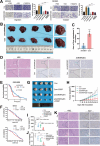Helicobacter Pylori-Enhanced hnRNPA2B1 Coordinates with PABPC1 to Promote Non-m6A Translation and Gastric Cancer Progression
- PMID: 38887155
- PMCID: PMC11321670
- DOI: 10.1002/advs.202309712
Helicobacter Pylori-Enhanced hnRNPA2B1 Coordinates with PABPC1 to Promote Non-m6A Translation and Gastric Cancer Progression
Abstract
Helicobacter pylori (H. pylori) infection is the primary risk factor for the pathogenesis of gastric cancer (GC). N6-methyladenosine (m6A) plays pivotal roles in mRNA metabolism and hnRNPA2B1 as an m6A reader is shown to exert m6A-dependent mRNA stabilization in cancer. This study aims to explore the role of hnRNPA2B1 in H. pylori-associated GC and its novel molecular mechanism. Multiple datasets and tissue microarray are utilized for assessing hnRNPA2B1 expression in response to H. pylori infection and its clinical prognosis in patients with GC. The roles of hnRNPA2B1 are investigated through a variety of techniques including glucose metabolism analysis, m6A-epitranscriptomic microarray, Ribo-seq, polysome profiling, RIP-seq. In addition, hnRNPA2B1 interaction with poly(A) binding protein cytoplasmic 1 (PABPC1) is validated using mass spectrometry and co-IP. These results show that hnRNPA2B1 is upregulated in GC and correlated with poor prognosis. H. pylori infection induces hnRNPA2B1 upregulation through recruiting NF-κB to its promoter. Intriguingly, cytoplasm-anchored hnRNPA2B1 coordinated PABPC1 to stabilize its relationship with cap-binding eIF4F complex, which facilitated the translation of CIP2A, DLAT and GPX1 independent of m6A modification. In summary, hnRNPA2B1 facilitates the non-m6A translation of epigenetic mRNAs in GC progression by interacting with PABPC1-eIF4F complex and predicts poor prognosis for patients with GC.
Keywords: Helicobacter pylori; gastric cancer; hnRNPA2B1; non‐m6A; translation.
© 2024 The Author(s). Advanced Science published by Wiley‐VCH GmbH.
Conflict of interest statement
The authors declare no conflict of interest.
Figures







References
MeSH terms
Substances
Grants and funding
LinkOut - more resources
Full Text Sources
Medical
Miscellaneous
